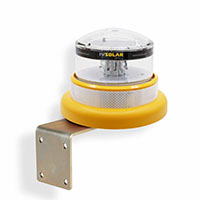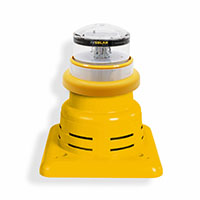
All-in-One: Yesterday and Today of Obstruction Warning Lights
Still today some classic luminous obstruction warning lights are installed, illuminated with a classic “E25 screw” lamp. Covered by an…
+ infoSolar powered beacon, designed for use in wind turbines, meteorological and telecommunications towers, cranes, chimneys, bridges or any structure up to 45m high. Also used in airports, marinas and ports.
It has the ICAO STAC certification for Type E low intensity beacons.
 Low intensity <45m
Low intensity <45m
 Intensity 32Cd
Intensity 32Cd
 Solar
Solar
Power source: Solar energy with built-in batteries (“All in One” equipment).
Operation: Autonomous beacon, during the day it recharges the batteries and the light switches on automatically at night.
Indicated for: Signaling of obstacles up to 45m high.
Autonomy:
Up to 200 hours (starting from a 100% charged battery)
Attention: The autonomy of the battery can be affected significantly depending on the weather conditions.
Configurator: Remote IV-CRF configurator option to change the mode and/or operation of the beacon.
Light colors: Red (standard), White, Amber, Green, Blue.
Mode: 20 flashes per minute, 30 flashes per minute, 40 flashes per minute.
Operation: Night only.
Twilight sensor: Integrated.
Flash synchronization: GPS synchronization option.
Fault alarm: Option, through “Dry contact” connectable to datalogger.
Telecommunications: It can be integrated into the IV-Manager System environment for beacon management and monitoring from a remote location.

Fijación lateral:
Fijación a tubo vertical (20 a 60mm de diámetro) o a pared.

“New Jersey” horizontal fixing:
For horizontal support (floor, wall crest, etc…).

“Fence” horizontal fixing::
For an horizontal structure (cranes, fences, etc…)

Fixation for aerodrome/airport deflector (45º inclination):
Special for runway head deflectors in aerodromes and airports.

Cone support for fixing on the ground:
Used in aerodromes/airports, mines, etc. It can be attached to the ground with screws.
Complete the form and we will contact you as soon as possible.

Still today some classic luminous obstruction warning lights are installed, illuminated with a classic “E25 screw” lamp. Covered by an…
+ info
The Spanish government has submitted its 2030 National Energy and Climate Plan (NECP), raising the country’s ambitions on greenhouse gas…
+ info